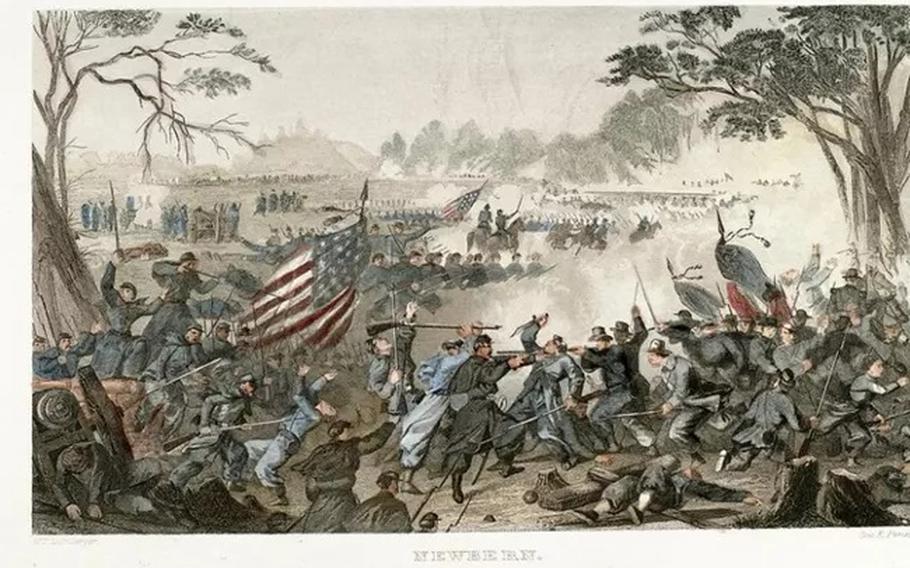
A lithograph of the 1862 Battle of New Bern, in which forces led by Union Gen. Ambrose Burnside fought for control of the strategic North Carolina port of New Bern. Later that year, an unusual ship under Burnside’s leadership — the USS Picket — exploded for unknown reasons and sank near Washington, N.C. (North Carolina Department of Natural and Cultural Resources)
(Tribune News Service) — A confounding act of nature has uncovered one of the nation’s most unusual wartime shipwrecks in eastern North Carolina.
The Union gunboat USS Picket spent much of the past 163 years buried in mud in the Tar River, about a 110-mile drive southeast from Raleigh.
But for reasons unknown, up to 7 feet of riverbed has been scoured away, excavating parts of the 130-foot-long ship not seen since it sank in 1862, according to Nathan Richards, director of the Maritime Studies program at East Carolina University’s Department of History.
The discovery was made as Richards led an ECU field school at the wreck site, and divers started seeing details that are uncommon among Civil War military shipwrecks.
The USS Picket is essentially two shipwrecks, or as Richards explains: “An iron-hulled watercraft ‘wrapped’ in a larger wooden hull, integrating the earlier structure into the U.S. Army gunboat.”
“We are able to access previously unseen parts of the ship that have long been buried. Added to this, the site is well known for having very bad visibility for divers (mere inches), but we have been very lucky to have had several feet of visibility,” Richards told McClatchy News in a phone interview.
“The wreck is largely intact below deck level. ... It appears to not only be intact bow(s) to stern(s) but there is 7 (feet) of exposed structure in many places.”
The Picket remains completely submerged, but two-thirds of the hull are now free of mud, providing the team with “tantalizing clues” of how two distinctly different types of American ship building were merged in desperate times.
Ship within a ship
The USS Picket exploded in mid battle in 1862, killing 19 crewmen and the captain, historians say.
Before that, it led the kind of history that makes for a great war story. It had been a flagship for Maj. Gen. Ambrose E. Burnside, who led a notorious “motley fleet” crewed by sailors who “conformed to neither Army nor Navy standards,” NCpedia.org reports.
Its mission was to shut down North Carolina’s ports and starve the Confederacy of supplies, and the fleet did its job well.
The Picket was among the smallest of the fleet, and its unusual construction resulted from an urgency to expand the Union’s naval capabilities.
“At least three other Civil War ships were created in a similar way, but none survived to be studied by historians,” Maritime Studies graduate student Rebecca Kelley, who is writing a thesis on the wreck’s construction, told McClatchy News in an email.
The Winslow, built in 1845, represents one of the earliest examples of iron ship construction, and its hull is still intact, Kelley says.
And because the wreck was encased in protective mud, much of the timber that made up the Picket’s hull is also still there, she says.
That makes the Picket a rare opportunity for researchers.
The Picket’s last day
Little is known about the history of the Winslow, which was a barge built for New York’s canal system, historians say.
“They are the least romantic type of ship. They often don’t have stories associated with them or a spectacular romantic narrative that allow us to track them through history. Nothing really incredible happens to them,” Richards says.
“But it was transformed in multiple ways when it became the Picket. It was a witness to multiple battles as part of the Picket and was a flagship. It really went from a nondescript thing to something of prominence.”
The Picket was used to transport Union troops and was a participant in a number of assaults on Confederate forces in North Carolina, Richards says.
Its final battle was Sept. 6, 1862, when Confederates pulled off a surprise attack on federal troops near Washington, North Carolina, according to the N.C. Maritime Museum in Beaufort.
“The gun boats, Picket and USS Louisiana began to shell advancing opponents. The Picket was only able to fire one gun before something went wrong onboard,” the museum reports.
The cause of that explosion remains unclear. It could have been the ship’s magazine exploding or its boiler, Richards says.
Why the shipwreck is important
The wreck of the Picket may deteriorate more rapidly now that it’s no longer protected by mud, and that means the field school’s use of emerging technology comes at a critical time.
When completed, an updated 3D interpretation will tell the story of something bigger than a Civil War gunboat.
The Picket represents emerging technology, industry and science from a time when the United States was evolving into a super power, Richards says.
“Faced with the ‘rude test of war’ both the Union and Confederate forces leverage technical know-how in many interesting ways,” Richards says.
“The adaptation of civilian craft into vessels of war is one major theme — and we aren’t aware of too many cases where an iron vessel used in the New York canal trade was adapted so extensively and ‘strangely.’
“Information from the wreck site provides a window into this period of experimentation and innovation under rare circumstances. Little of this seems to have been preserved in written records.”
Kelley’s thesis could be the most in-depth analysis made public on the ship’s mysterious construction, Richards said.
©2025 The Charlotte Observer.
Visit charlotteobserver.com.
Distributed by Tribune Content Agency, LLC.